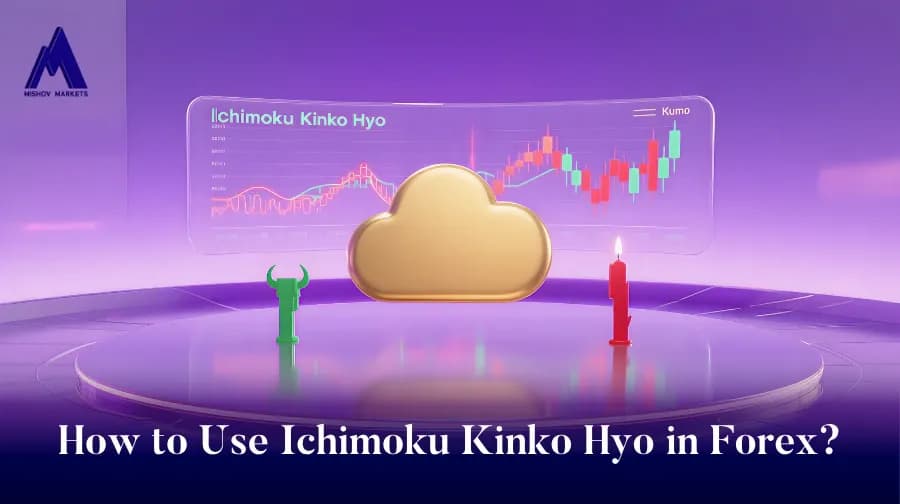How to Use Ichimoku Kinko Hyo in Forex

Trading Ichimoku is an excellent choice for beginners looking to dive into the world of market analysis. The Ichimoku Kinko Hyo, often referred to as the Ichimoku indicator, is a powerful tool that offers a comprehensive view of market trends, momentum, and key support or resistance levels at a glance. It’s especially popular in forex trading, but it can be used across various financial markets, including stocks and commodities. The beauty of trading Ichimoku lies in its ability to simplify complex data, enabling traders to spot trends, reversals, and potential entry and exit points. The five key components—Tenkan-sen, Kijun-sen, Senkou Span A, Senkou Span B, and Chikou Span—offer a structured way to interpret the market. By incorporating the Ichimoku Cloud into your strategy, you can easily assess whether the market is trending or ranging, making it an indispensable tool for any beginner looking to trade with confidence.
What is the Ichimoku?
The Ichimoku Kinko Hyo, commonly called the Ichimoku indicator, is a versatile tool widely used in forex trading and other financial markets to analyze price action and identify potential trading opportunities. Its name means "one glance equilibrium chart," highlighting its ability to provide a quick and comprehensive view of the market’s condition. The indicator has five lines that identify trends, momentum, and key support and resistance levels. These components consist of the Tenkan-sen (conversion line), Kijun-sen (baseline), Senkou Span A, Senkou Span B (which together create the Ichimoku cloud or Kumo), and the Chikou Span (lagging line). The Ichimoku clouds are one of the most distinctive and valuable aspects of this tool. They provide a visual representation of the market’s trends and strengths. When the Span A is higher than the Span B (bullish Kumo), it indicates an uptrend. Conversely, when the Span A is lower than the Span B (Bearish Kumo), it signals a downtrend. A thicker cloud suggests a stronger trend, while thinner clouds may indicate potential market instability or a possible trend reversal. Additionally, the cloud is projected forward, giving traders a glimpse of possible future market conditions.
Trading Ichimoku Clouds helps traders make informed decisions about entries and exits. For example, when the price breaks above the cloud and other lines align in a bullish manner, it can signal a buying opportunity. Conversely, a break below the cloud with bearish line alignment may signal a sell opportunity. By combining these insights with other market analysis techniques, traders can enhance their strategies and improve their success in forex trading with Ichimoku.
How does the Ichimoku work?
The forex Ichimoku indicator operates by integrating five essential lines that offer a comprehensive perspective on market trends, momentum, and potential support or resistance levels, making it a highly effective tool for Ichimoku trading. These lines include:
1. Tenkan-sen (Conversion Line):
It reflects the short-term trend and is determined by averaging the highest high and lowest low over a specific period, typically 9 periods.
2. Kijun-sen (Baseline):
Represents the medium-term trend, calculated similarly as tenkan-sen but over a longer period (commonly 26 periods).
3. Senkou Span A (Leading Span A):
Forms one edge of the Ichimoku Cloud, calculated as the average of the Tenkan-sen and Kijun-sen, projected forward 26 periods.
4. Senkou Span B (Leading Span B):
The second edge of the cloud, calculated as the average of the highest high and lowest low over 52 periods, also projected forward 26 periods.
5. Chikou Span (Lagging Line):
This represents the current closing price plotted 26 periods behind, showing how current prices compare to past movements.
The Ichimoku Cloud, or Kumo, is a critical component for trading Ichimoku as it visually identifies the market’s trend. When the price is above the cloud, it may signal a bullish trend, prompting traders to seek buying opportunities. Conversely, if the price is below the cloud, it indicates a bearish trend, suggesting potential selling opportunities. The thickness of the cloud represents the trend’s strength, with thicker clouds indicating stronger trends.
By observing the alignment of these lines and how the price interacts with the cloud, traders using trading Ichimoku can identify trends, potential reversals, and key entry or exit points in a straightforward and efficient way.
How to trade with Ichimoku?
Trading with Ichimoku can be simple if you break it down into a few easy steps. The Ichimoku indicator helps you see the trend, find support and resistance, and spot potential trade signals. Here's how you can use it:
1. Identify the Trend
- Look at where the price is compared to the Ichimoku Cloud (Kumo):
- If the price is above the cloud, it could be showing an uptrend—look for buying opportunities.
- If the price is below the cloud, it’ could be showing a downtrend—look for selling opportunities.
- If the price is inside the cloud, the market is uncertain or ranging.
2. Use the Tenkan-sen and Kijun-sen for Signals
- The Tenkan-sen (Conversion Line) and Kijun-sen (Baseline) show short-term and medium-term trends.
- A bullish signal happens when the Tenkan-sen crosses above the Kijun-sen (a buy signal).
- A bearish signal happens when the Tenkan-sen crosses below the Kijun-sen (a sell signal).
3. Confirm with the Cloud and Chikou Span
- Check if the signal is strong by confirming it with the Ichimoku Cloud:
- For a buy trade, the price must be above the cloud, and the cloud itself should indicate a bullish trend, meaning Senkou Span A is positioned above Senkou Span B.
- For a sell trade, the price must be below the cloud, and the cloud should indicate a bearish trend, meaning Senkou Span B is positioned above Senkou Span A.
- The Chikou Span (Lagging Line) should be above the price for a buy trade and below the price for a sell trade.
4. Enter and Manage the Trade
- Entry Point: Enter the trade after confirming the signals.
- Stop Loss: Place your stop loss below the cloud for a buy trade or above the cloud for a sell trade.
- Take Profit: Look for key resistance levels (in an uptrend) or support levels (in a downtrend) to set your target.
By following these steps, you can effectively use trading with Ichimoku to identify strong trends and make confident trading decisions.
What is The Best Setting for Ichimoku?
The best settings for trading Ichimoku depend on your trading style, the market you’re trading, and your chosen timeframe. The default settings—9, 26, 52—are widely used because they provide a balanced approach to analyzing trends, momentum, and support/resistance levels. These settings work well in forex and other markets, especially on daily and higher timeframes.
Default Settings for Trading Ichimoku:
- 9 (Tenkan-sen): Represents short-term trends, calculated over 9 periods.
- 26 (Kijun-sen): Represents medium-term trends, calculated over 26 periods.
- 52 (Senkou Span B): Represents long-term trends, calculated over 52 periods.
These settings are ideal for swing and position traders who want to spot trends and reversals.
Custom Settings for Trading Ichimoku:
1. Shorter Settings (e.g., 9, 18, 26):
- Often used by day traders or scalpers for faster signals.
- Makes the indicator more responsive but increases the risk of false signals.
2. Longer Settings (e.g., 18, 35, 60):
- Suitable for swing and long-term trading.
- Helps reduce noise in volatile markets, but signals may lag.
3. Forex-Specific Settings (e.g., 26, 52, 78):
- Some forex traders adjust settings to better align with the 24-hour market cycle.
- This provides smoother trends for trading Ichimoku on forex pairs.
While the default settings are reliable for most traders, finding the best Ichimoku settings is about aligning the indicator with your trading goals and style.
Is Ichikomo Still Popular Among Users?
Yes, trading Ichimoku remains very popular among traders worldwide. Despite being developed in the late 1930s, the Ichimoku indicator is still widely used because of its versatility and ability to provide a comprehensive view of market trends, momentum, and key levels at a glance. Many traders, especially in forex, stocks, and commodities, rely on it to identify trends, spot reversals, and set precise entry and exit points. The visual approach of Ichimoku trading, especially the Ichimoku Cloud (Kumo), makes it attractive to both beginner traders and experienced professionals alike. It simplifies complex market movements, helping traders quickly determine whether the market is trending, ranging, or reversing. Its popularity also stems from its adaptability, as traders can use it on various timeframes and customize its settings to suit their strategies.
With the rise of algorithmic trading and advanced charting platforms, trading Ichimoku continues to be relevant, proving its effectiveness in modern markets.








